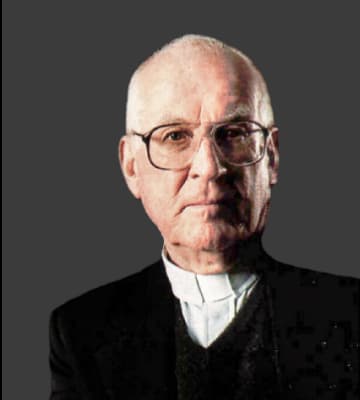Emeritus Staff

Rev. Sabino Maffeo, S.J.
Fr. Sabino Maffeo, S.J. is the assistant to the director of the Vatican Observatory. He was born in Somma Vesuviana, Naples, Italy in 1922 and joined the Jesuits in 1937 at the age of 15. He earned a B.A. in philosophy and a B.A. in theology at the Pontifical Gregorian University in Rome, and was ordained a priest in 1953.
He earned his Masters in physics in 1957 from the University of Rome and Florence; his thesis topic dealt with the propagation of neutrons slowed by graphite. He taught physics at the Istituto Massimiliano Massimo in Rome, and he was president of the same school from 1962 to 1968, at which time he was appointed provincial of the Roman Province of the Society of Jesus, a post he held from 1968 to 1973. Following that, he served as technical director of Vatican Radio (1973-1985).
He joined the Vatican Observatory in 1985 as Vice Director and Administrator, and has served as the assistant to the director since 2003.
In Memoriam

Rev. William R. Stoeger, S.J.October 5, 1943 - March 24, 2014
Rev. William R. Stoeger, S.J. was born in 1943 in Torrance, California and grew up in Redondo Beach, California. He was a staff scientist for the Vatican Observatory Research Group in Tucson, specializing in theoretical cosmology, high-energy astrophysics, and interdisciplinary studies relating to science, philosophy and theology.
He entered the Society of Jesus in September 1961, and in 1967 completed his bachelor’s degree with honors in philosophy from Spring Hill College, Mobile, Alabama. In 1969 he was awarded an M.S. in physics from UCLA. After lecturing briefly in the physics department at the University of San Francisco, he began theological studies at the Jesuit School of Theology in Berkeley, California where he finished an S.T.M. and was ordained to the priesthood in 1972. Afterwards he pursued doctoral studies in astrophysics at Cambridge University, U.K., and completed his PhD in 1976. From 1976 – 1979 he was a research associate with the theoretical gravitational physics group at the University of Maryland, College Park, Maryland. He joined the staff of the Vatican Observatory in September 1979.
Rev. Stoeger’s research dealt with various problems connected with the physics of accretion onto black holes, and mathematical and physical issues connected with torsion and bi-metric theories of gravity, as well as the harmonic map structures contained in gravitational theories, including general relativity. More recently, he concentrated on observationally oriented projects in theoretical cosmology, attempting to build more adequate bridges between theory and cosmologically relevant astronomical observations. He also pursued some research on the physics of the central engine in active galactic nuclei and quasars.
Besides his research and writing in cosmology and astrophysics, Rev. Stoeger was active in lecturing and teaching at the University of Arizona, at the University of San Francisco, and at Vatican Observatory Summer Schools. He was a member of the American Physical Society, the American Astronomical Society, and the Society for General Relativity and Gravitation. He was on the Board of the Center for Theology and the Natural Sciences (CTNS), Secretary of the Vatican Observatory Foundation, and co-editor of the series “Philosophy in Science.” He was an active participant in the Vatican/CTNS workshops on “God’s Action in the World: Scientific Perspectives on Divine Action” and in the Science-Theology Consultation of the Center of Theological Inquiry, Princeton.

Rev. Andrew Whitman, S.J. February 28, 1926 - January 7, 2015
Rev. Andrew Whitman, S.J. was born in Detroit, MI, on February 28, 1926, into a very loving, Catholic family. But within a few years the Depression hit the motor city and everything collapsed — jobs, mortgage, etc. — and chaos reigned.
And so the Fall of 1931 his mother and father decided to head South in search of whatever jobs were out there. They found a haven in Roanoke, VA, Spartenburg, SC, Tryon, NC, and finally in the Spring of 1933 they landed in New Orleans. This became their home.
He went to public grade school, public high school, and finally with a scholarship he attended Tulane University during the War years from 1942 to 1945. He graduated with a degree in Civil Engineering and entered the workforce. But he was soon stricken down with a debilitating disease and where faced almost certain death. But something happened and that dreadful sentence did not occur, and he was fortunate enough to enter the Jesuits in 1951. The humanities and philosophy studies were exciting and in 1957 he went off to Washington, D.C., and started his Ph.D. degree in mathematics at The Catholic University of America under the renowned geometer, Dr. Katsumi Nomizu. He received the degree in 1961 and went on to theology studies, being ordained a priest in 1963. During these studies he had the great privilege of having the renowned Rev. John Courtney Murray, S.J., as the director of his Licentiate Degree in Theology.
He started his professional career teaching at Loyola University in New Orleans in 1967. After two years at Loyola University in New Orleans, he spent seven years (1967-1974) at the University of Houston, where he earned a tenured position of Associate Professor in the Department of Mathematics. It was during these years where the paper on finite deformation theory in elasticity was conceived. At the invitation of Professor Paul Schweitzer he joined (in 1974) the faculty of the Pontifícia Universidade Católíca of Rio de Janeiro, where he was a tenured Associate Professor. In 1982-83 he took a sabbatical year at the Vatican Observatory, where he joined the staff as an adjunct scientist in 1983. During this period he worked with Rev. William Stoeger of the Vatican Observatory staff on research on the project of Professor G.F.R. Ellis, and on harmonic maps using the space of all Lorentzian metrics in the theory of gravitation. This also initiated a long and fruitful collaboration with Professor Ronald Knill of Tulane University. He returned to the United States in 1989 and took the position of Lecturer at the College of the Holy Cross. In 1996 he joined the staff of the Vatican Observatory and was stationed at the Vatican Observatory Research Group at the University of Arizona as a research scientist. In 1998 he was appointed as a permanent member of the staff of the Vatican Observatory and also took on duties of an administrator.
In 1963 along with Lawrence Conlon, presently at Washington University in St. Louis, he formed the Clavius Group of mathematicians. This is a group of lay and religious mathematicians who meet each summer at various mathematical centers and departments to form a faith community and to do mathematics at levels from research to study seminars on current topics of interest to the group.
After fourteen years based at the University of Arizona as a research scientist for the Vatican Observatory, Whitman returned in August 2010 to his Jesuit Province of New Orleans, where he is assigned to St. Charles College at Grand Coteau, Louisiana. There he is a “writer” since he is completing a textbook in Lie Algebra. En route to Grand Coteau, Whitman assisted at the 12th Vatican Observatory Summer School, Castel Gandolfo, and attended the 48th annual gathering of the Clavius Group at the College of the Holy Cross.
Whitman’s colleagues at the Vatican Observatory and his many friends took the opportunity during his retirement to recognize his many years of cheerful and unique service to the Church and to mathematics. Through farewell parties in Tucson and at Castel Gandolfo we remain grateful for his contribution as a writer and member of the Jesuit community at Grand Coteau.

Rev. George V. Coyne, S.J.January 19, 1933 - February 11, 2020
Rev. George V. Coyne, S.J. was born on January 19, 1933 in Baltimore, MD, the third of nine children. He attended Catholic elementary schools and received a full scholarship to Jesuit-run Loyola Blakefield High School in Towson, MD. Upon graduation in 1951 he entered the Jesuit novitiate at Wernersville, PA. During his first year of studies in Latin and Greek literature, he was instructed by a Jesuit priest who, in addition to having a Ph.D. in the classical languages, also had a M.S. in mathematics and an educated interest in astronomy; he noticed George’s interest in astronomy and encouraged him in the field. George earned a B.S. in mathematics and licentiate in philosophy from Fordham University in 1958, a Ph.D. in astronomy in 1962 from Georgetown University, and finally the licentiate in sacred theology from Woodstock College in 1966, the year after his ordination.
For his doctorate in astronomy at Georgetown University, Coyne carried out a spectrophotometric study of the lunar surface. He spent the summer of 1963 doing research at Harvard University, the summer of 1964 as a National Science Foundation lecturer at the University of Scranton, and the summer of 1965 as visiting research professor at the University of Arizona Lunar and Planetary Laboratory.
Coyne’s main research interest was the study via polarimetry of a number of astronomical objects. These included the surfaces of the Moon and Mercury; the interstellar medium; stars with extended atmospheres; and Seyfert galaxies, which are a group of spiral galaxies with very small and unusually bright star-like centers. His final papers were on the polarization produced in cataclysmic variables, interacting binary star systems that give off sudden bursts of intense energy.
Coyne was visiting assistant professor at the University of Arizona Lunar and Planetary Laboratory (LPL) in 1966-67 and 1968-69, and visiting astronomer at the Vatican Observatory in 1967-68. He joined the Vatican Observatory as an astronomer in 1969 and became an assistant professor at the LPL in 1970. In 1976 he became a senior research fellow at the LPL and a lecturer in the University of Arizona Department of Astronomy. The following year he served as Director of the University of Arizona’s Catalina Observatory and as Associate Director of the LPL.
Coyne was appointed Director of the Vatican Observatory by Pope John Paul I in 1978, and in that same year he also became Associate Director of Steward Observatory. During 1979-80 he served as Acting Director and Head of Steward Observatory and the Astronomy Department, and thereafter he continued as an adjunct professor in the University of Arizona Astronomy Department.
He retired as Director of the Vatican Observatory in August 2006. After spending a sabbatical year as an Associate Pastor at St. Raphael’s Catholic Church in Raleigh, NC, he remained on the staff of the Vatican Observatory and served as President of the Vatican Observatory Foundation until 2011. In that year he was appointed to the McDevitt Chair of Religious Philosophy at Le Moyne College in Syracuse, NY.
Coyne was awarded honorary doctorate degrees by Boston College; the Jagellonian University in Krakow, Poland; Loyola University Chicago; Marquette University; St Peter’s College Jersey City; and the University of Padua, Italy. In 2008 Villanova University awarded Coyne the Mendel Medal, and in 2010 he was awarded the George Van Biesbroeck Prize by the American Astronomical Society. He was a member of the International Astronomical Union, the American Astronomical Society, the Astronomical Society of the Pacific, the American Physical Society, the Optical Society of America and the Pontifical Academy of Science.

